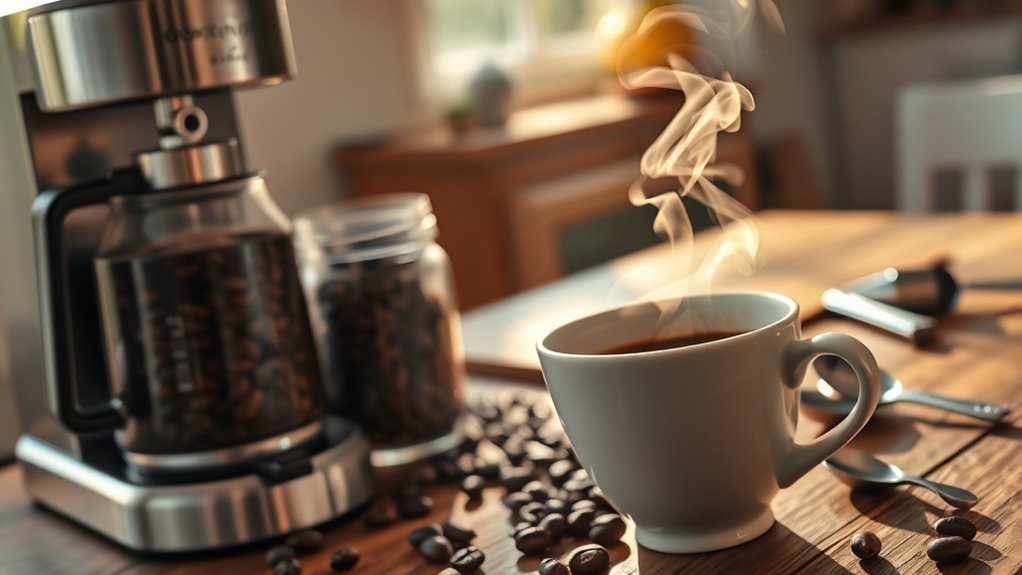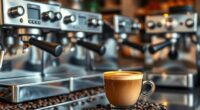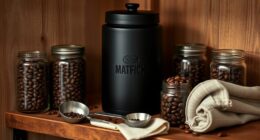To adjust coffee strength to your taste, start by tweaking the brew ratio—try a 1:15 ratio for a stronger cup or 1:18 for a milder flavor. Experiment with grind size; a finer grind extracts more flavor but may increase bitterness. Keep an eye on extraction percentage, ideally between 18% to 22%. Finally, document your findings to refine your brewing process over time. Keep exploring the nuances of coffee, and you’ll discover even more ways to elevate your brew!
Key Takeaways
- Adjust the brew ratio by varying the amount of coffee grounds to water; a 1:15 ratio makes stronger coffee, while 1:18 yields a milder taste.
- Experiment with grind size; a finer grind increases extraction and strength, while a coarser grind can decrease bitterness and enhance balance.
- Modify water temperature; hotter water extracts more flavors, but be cautious, as excessive heat can lead to bitterness.
- Control brew time; longer brewing increases extraction, while shorter times yield a lighter flavor profile, allowing for tailored strength adjustments.
- Keep detailed notes on your brewing process to track changes in strength and flavor; this helps refine your techniques over time.
Understanding Coffee Strength
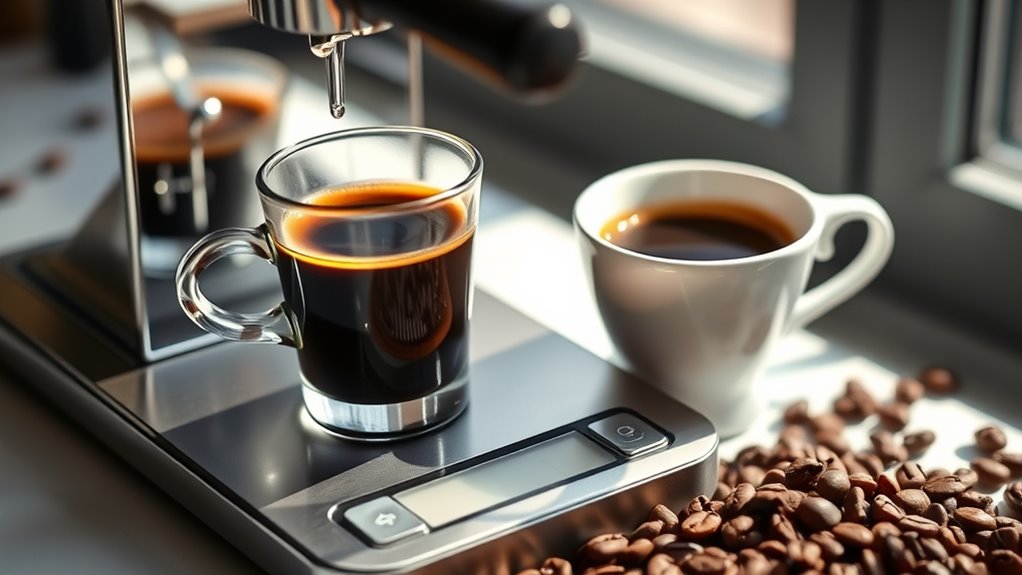
When you think about coffee strength, it’s important to realize that it’s all about the concentration of dissolved coffee solids in your cup. Average drip coffee contains about 1.25% solids, while espresso boasts around 10%.
The strength isn’t tied to roast level; it’s determined by the amount of coffee grounds and the brew ratio. For instance, a 1:16 brew ratio means using 1 gram of coffee for every 16 grams of water. Adjusting this ratio is essential to achieving your desired strength and flavor.
Additionally, understanding extraction percentages is vital. Aim for an ideal range of 18 to 22% to avoid a brew that’s too sour or bitter. With these adjustments, you’ll find your perfect cup.
Strength and Caffeine
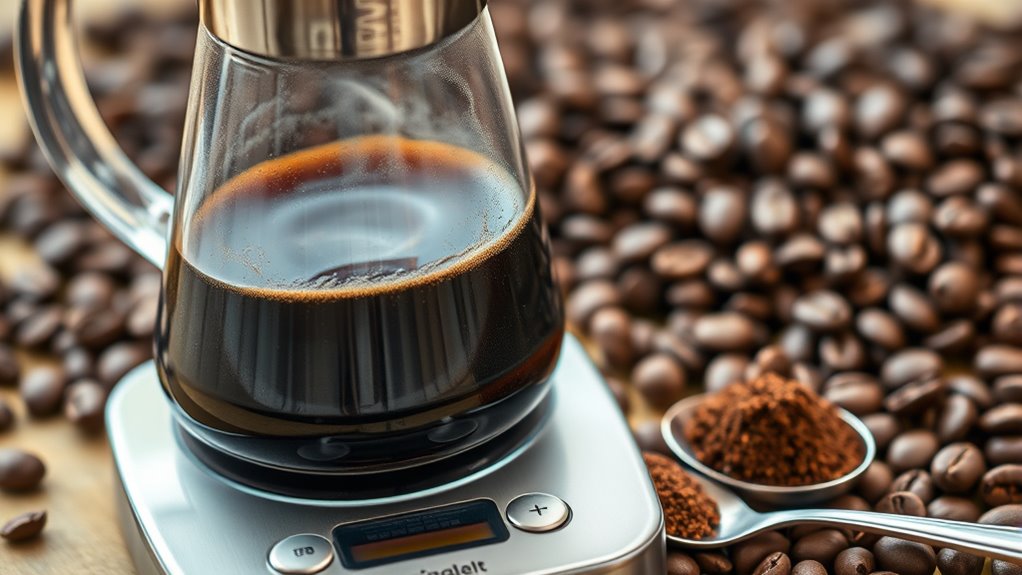
When you think about coffee strength, it’s easy to confuse it with caffeine content.
Espresso might pack more caffeine per ounce, but a regular cup of drip coffee often has a similar total caffeine amount.
Espresso vs. Drip Coffee
While many coffee lovers might assume that espresso’s rich flavor translates to higher caffeine levels, the reality is more nuanced.
Espresso has about 10% dissolved coffee solids, making it much stronger in flavor than drip coffee, which averages around 1.25%.
However, the total caffeine content in a double espresso is comparable to that of a standard cup of drip coffee because both use a similar ratio of coffee grounds.
This means that your perception of strength isn’t just about caffeine; it also depends on the brew methods and the concentration of dissolved solids.
Caffeine Concentration Explained
Understanding caffeine concentration is key to adjusting coffee strength to fit your preferences. While stronger coffee often feels more robust, it doesn’t always mean higher caffeine content. For instance, espresso has a higher caffeine concentration but uses similar amounts of coffee grounds as drip coffee, leading to comparable total caffeine levels.
To enhance your coffee experience, consider these factors:
- Brew Ratio: Increase coffee grounds relative to water for stronger flavors.
- Caffeine Delivery: Espresso offers quicker caffeine intake compared to drip coffee.
- Perceived Strength: Adjusting the brew ratio can modify your coffee’s strength without changing the caffeine content.
Strength Is Not Roast
Coffee strength often leads to misconceptions about roast levels, but it’s the concentration of dissolved solids that truly defines strength.
A light roast can be just as strong as a dark roast, depending on the amount of coffee used and the brew time. For instance, espresso has about 10% dissolved solids, while average drip coffee contains only about 1.25%.
This means that a small amount of coffee grounds can yield a stronger flavor in espresso compared to drip coffee. Even decaffeinated espresso can taste stronger due to its rich flavor compounds.
Brew Ratio
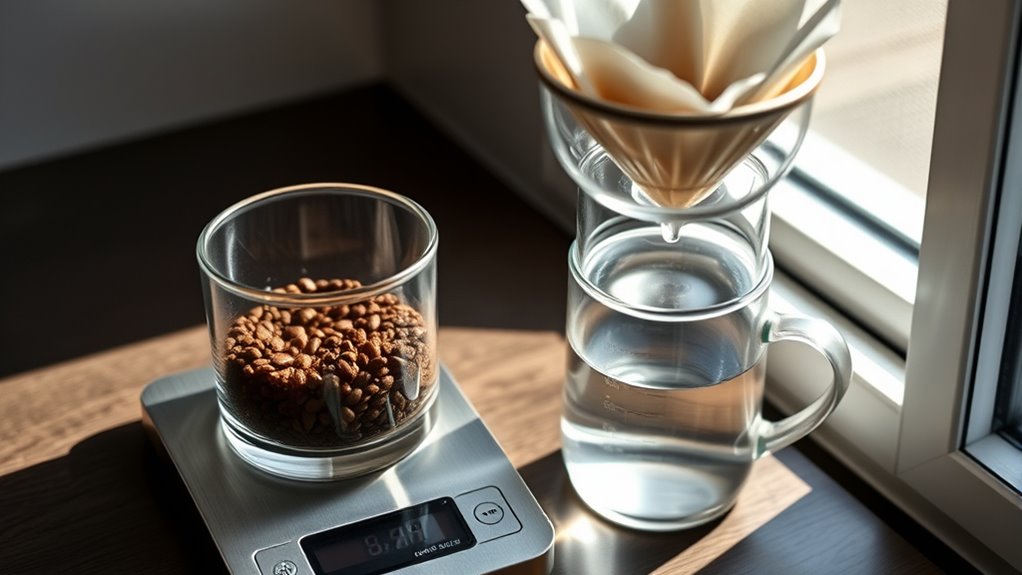
When it comes to brewing coffee, understanding the brew ratio is key to achieving your perfect cup.
By adjusting the amount of coffee you use, you can find the ideal balance between strength and flavor.
Let’s explore how to calculate these ratios and tweak them to suit your taste.
Understanding Brew Ratios
To brew a perfect cup, knowing the brew ratio is essential. This ratio indicates the amount of water relative to coffee grounds, with a common standard being 1:16.
Adjusting this ratio can greatly affect your coffee’s strength and flavor. For a stronger cup, try a 1:15 ratio, while a 1:18 ratio will yield a milder taste.
- Increasing coffee grounds intensifies flavor.
- Aim for an extraction percentage between 18% to 22%.
- Use a scale for precise measurements.
Adjusting Coffee Amounts
Adjusting coffee amounts can transform your brewing experience, especially when you consider the impact of different brew ratios. The coffee to water ratio is essential for achieving your desired flavor. For instance, a standard 1:16 ratio offers a balanced taste, while a 1:15 ratio intensifies the flavor, and a 1:18 ratio results in a milder brew. Here’s a quick reference table to guide your adjustments:
| Brew Ratio | Coffee (grams) | Water (grams) |
|---|---|---|
| 1:15 | 16.7 | 250 |
| 1:16 | 15.6 | 250 |
| 1:17 | 14.7 | 250 |
| 1:18 | 13.9 | 250 |
| 1:20 | 12.5 | 250 |
Weigh both coffee and water to maintain consistency and make adjustments based on how you want your coffee to taste.
Finding Ideal Balance
Finding the ideal balance in your brew ratio is crucial for crafting the perfect cup of coffee, as it directly influences flavor and strength. A common standard is 1:16, meaning one gram of coffee to 16 grams of water, but adjusting this can enhance or mellow your coffee’s flavor.
- For stronger coffee, try a 1:15 ratio.
- For a milder taste, opt for a 1:18 ratio.
Weighing your coffee and water guarantees consistent brew ratios for maximum coffee strength. Additionally, using coarsely ground coffee is essential for optimal extraction when brewing methods like the French Press are employed.
Experimenting with different brew ratios helps you discover your personal taste preferences and achieve the ideal extraction percentage of 18% to 22%. With practice, you’ll fine-tune your coffee to perfection!
Extraction Percentage
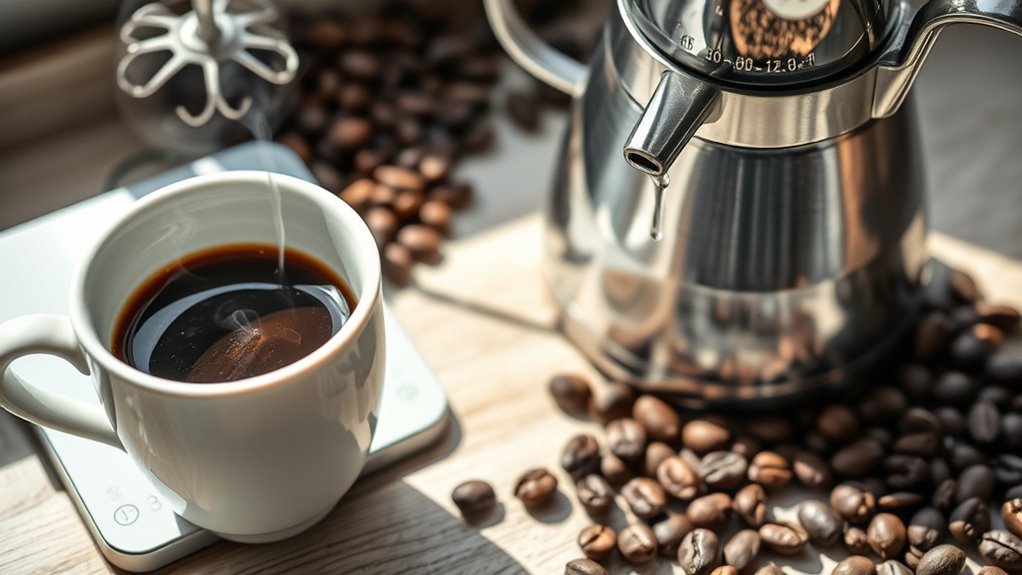
The extraction percentage is an essential factor that shapes the flavor profile of your coffee. Aim for an extraction percentage of 18 to 22% for a balanced brew, optimizing desirable compounds while minimizing bitterness. You can adjust variables like grind size and water temperature to influence extraction. Understanding the mechanics of French press coffee can also help you achieve your desired strength.
| Variable | Impact on Extraction | Recommended Adjustments |
|---|---|---|
| Grind Size | Finer increases extraction | Use coarser for less extraction |
| Water Temperature | Hotter extracts more | Lower temp for milder taste |
| Brew Time | Longer boosts extraction | Shorten for lighter flavor |
Dilution and Bypass Brewing
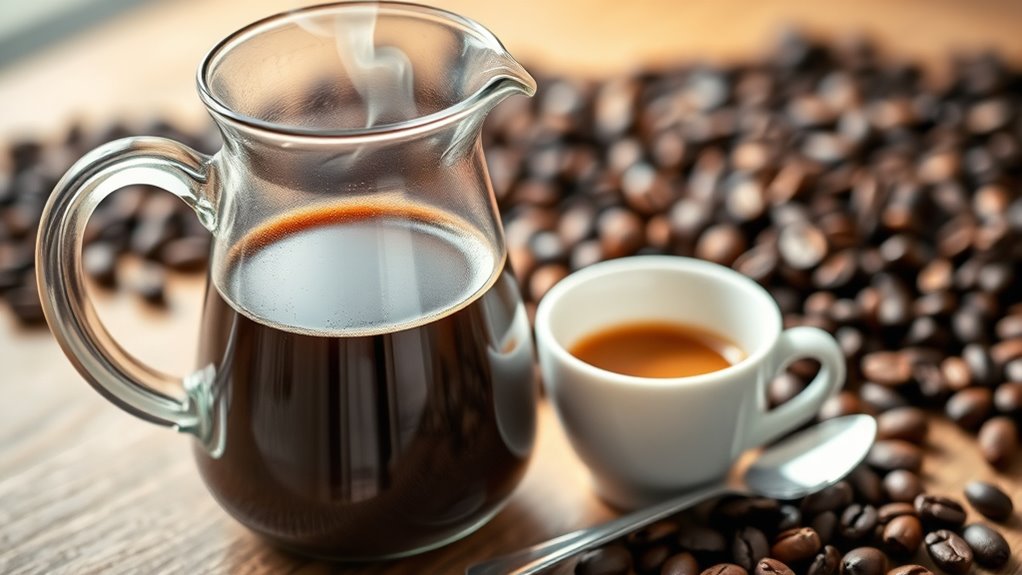
After considering extraction percentages, you might want to explore how dilution and bypass brewing can further adjust your coffee’s strength.
Dilution involves adding water to brewed coffee, creating a milder flavor without a second brewing. Bypass brewing, on the other hand, allows water to flow around the coffee grounds, producing a stronger brew.
Here are some practical ways to implement these methods:
- Flash-chilled iced coffee offers a revitalizing way to enjoy diluted coffee.
- Americanos combine espresso with hot water for a balanced flavor.
- Adjust your coffee-to-water ratios in future brews to achieve peak strength.
Keep in mind that while dilution can enhance flavor and reduce bitterness, future adjustments to your brewing variables will guarantee the best results.
Adjusting Dose and Grind
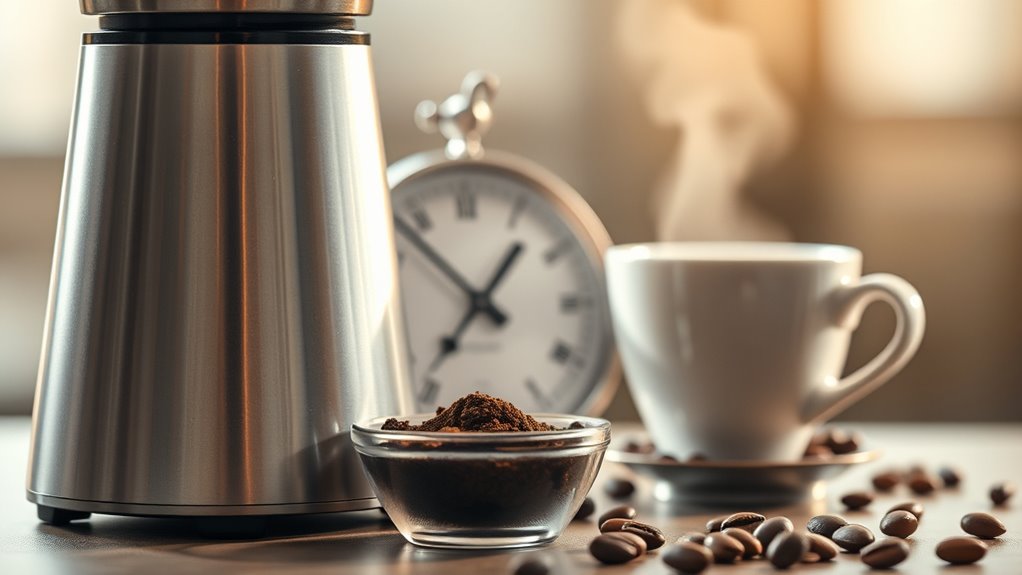
Adjusting the dose and grind of your coffee can greatly impact its flavor profile.
If you’re brewing coffee that’s bland, try increasing the dose and coarsening the grind. This approach enhances sweetness and body by reducing the sugar proportion in the extraction.
Conversely, if your coffee tastes aggressive, decrease the dose slightly and grind finer to bring out those caramel and sugar notes.
For bright coffee that’s overly acidic, keep the dose the same but grind finer to slow extraction and reduce acidity.
To tackle bitterness, maintain the same dose but coarsen the grind size for faster extraction, balancing acidity and bitterness.
Finding that perfect balance requires careful adjustments based on your specific taste observations.
Analyzing Shot Taste
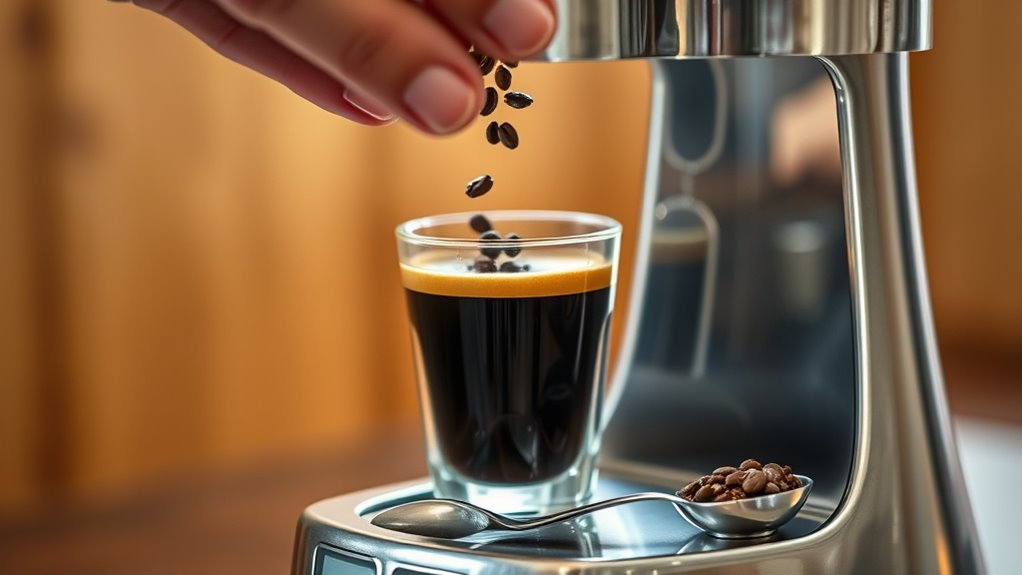
When you’re evaluating the taste of your espresso shot, consider three key elements: sweetness, acidity, and roasty flavors. A balanced shot harmonizes these flavors.
When tasting your espresso, focus on balancing sweetness, acidity, and roasty flavors for the perfect shot.
If it tastes bland, try increasing the dose and using a coarser grind size to enhance complexity. For an aggressive flavor, reduce the dose and grind finer to highlight the caramel notes.
Bright coffees can benefit from grinding finer while maintaining the same dose to slow extraction and minimize acidity. If you’re dealing with bitterness, keep the dose steady but coarsen the grind to speed up extraction and improve balance.
- Taste for sweetness and acidity.
- Experiment with grind sizes.
- Adjust dose for flavor enhancement.
Take Notes

Taking notes during your brewing sessions can greatly enhance your coffee-making skills.
Maintain a dedicated notebook to document each brew, including the coffee type, roaster, and brew method. Record the specific coffee-to-water ratio, grind size, and brew time for every recipe. This helps guarantee consistency and makes it easy to adjust in future brews.
Also, note your observations on flavor profiles, such as sweetness, acidity, and bitterness, to identify your preferences and areas for improvement. Use precise measurements, weighing coffee doses to the nearest 0.1 grams, for accuracy.
Regularly review and analyze your notes to refine your techniques and achieve the desired coffee strength and flavor balance. Your notes are key to releasing the perfect cup!
Frequently Asked Questions
How to Adjust Coffee Based on Taste?
To adjust coffee based on taste, start by experimenting with the amount of coffee grounds you use.
If it tastes bland, try increasing the coffee dose and coarsening the grind. For a smoother flavor, decrease the dose and grind finer.
If you’re getting bitterness, coarsen the grind while keeping the dose the same.
Finally, for bright coffee, maintain the dose and grind finer to balance acidity and enhance flavors.
Enjoy your perfect cup!
What Is the 80/20 Rule for Coffee?
Did you know that 80% of your coffee’s flavor comes from just 20% of the brewing variables? This is the essence of the 80/20 rule for coffee.
It highlights how focusing on key factors, like coffee-to-water ratio and grind size, can greatly enhance your brew.
How Do I Make My Coffee Taste Stronger?
If you want your coffee to taste stronger, start by tweaking the coffee-to-water ratio; aim for about 1:15.
Try using a finer grind size to enhance extraction. You can also extend your brewing time a bit, but be careful not to overdo it, or you’ll get bitterness.
Finally, raise the water temperature slightly between 195°F and 205°F to help dissolve more flavors. Quality beans can make a big difference too!
How Do I Drink Coffee if I Don’t Like the Taste?
If you don’t like the taste of coffee, start by adding milk or cream to soften the flavor.
Sweeteners like sugar or flavored syrups can help mask bitterness and balance acidity.
You might also try sprinkling some cinnamon or nutmeg into the brew for a new twist.
Flavored creamers can drastically change the taste too.
Finally, consider lighter roasts or cold brews for a smoother experience that’s easier on your palate.
Conclusion
Finding your perfect coffee strength is like tuning a musical instrument—every adjustment brings you closer to that harmonious flavor. By experimenting with brew ratios, grind size, and extraction, you can create a cup that sings to your taste buds. Don’t hesitate to take notes on your brewing journey, as it’ll help you refine your technique. Remember, coffee is a personal experience, so keep fine-tuning until you find your ideal brew that hits all the right notes.
